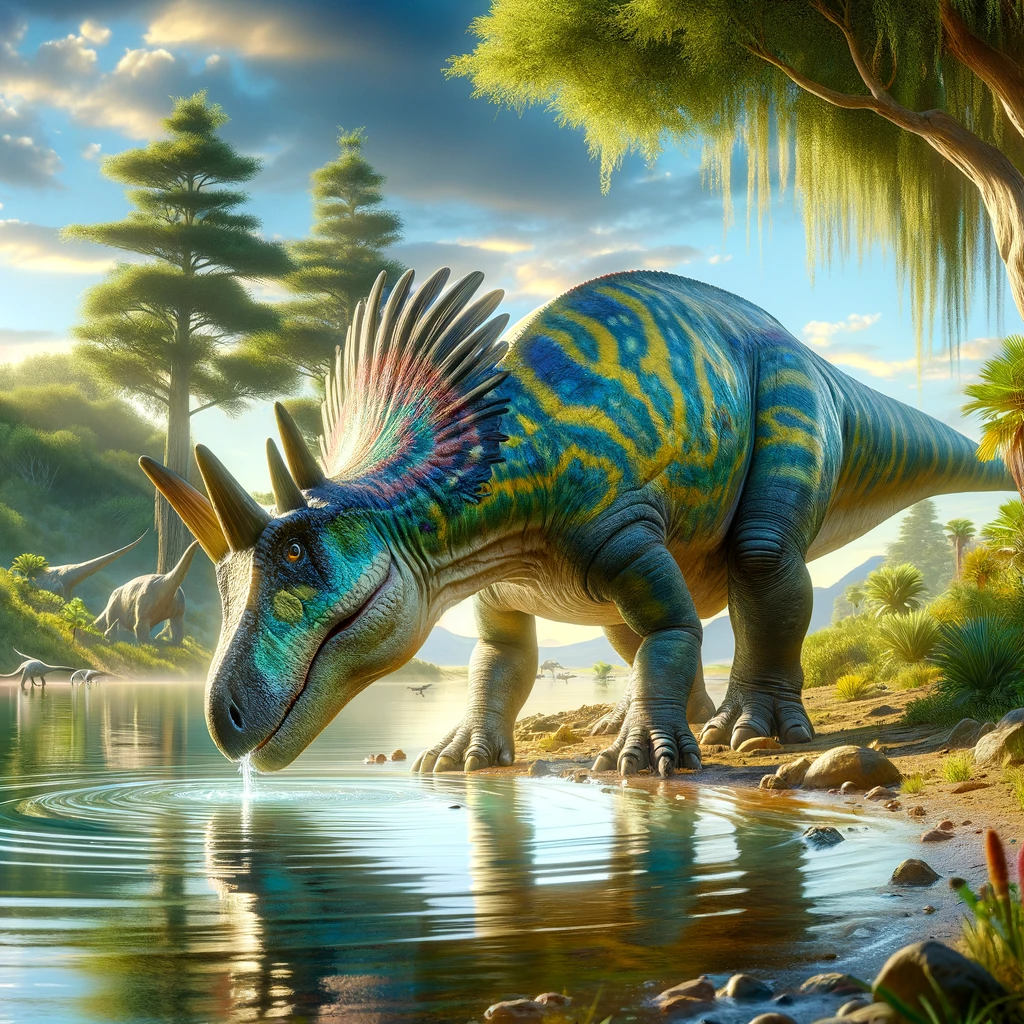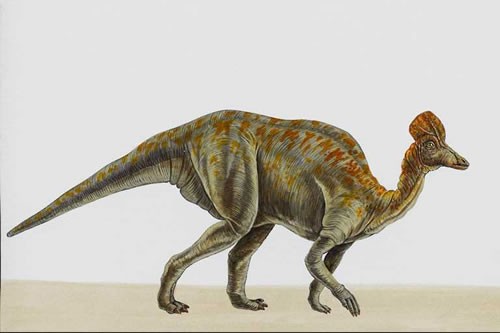Corythosaurus–Exploring Its Wondrous World
The world of dinosaurs never stops fantastic us. From the huge T-rex to the tiny Microraptor, every dinosaur species has its unique features and abilities. Today, let’s step into the world of Corythosaurus, one of the most exciting and unique dinos out there.
This duck-billed dinosaur lived during the Late Cretaceous period, about 80 million years ago, and it left us many clues about its lifestyle that we can explore today. From its distinctive crest to its unbelievable hearing abilities, let’s take a closer look at the fantastic Corythosaurus creature.
Corythosaurus–Thriving in Late Cretaceous North America
Corythosaurus lived in what is now North America during the late Cretaceous period, specifically in parts of modern-day Montana, Wyoming, and Canada. The area at that time was a massive floodplain with rivers and streams.
The warm and humid climate led to the growth of lush forests and vegetation, which provided an abundant food source for herbivores like the Corythosaurus. These herbivorous dinosaurs might have fed on various plants, including horsetails, ferns, cycads, and angiosperms.
Diet of the Beast
As mentioned, Corythosaurus was an herbivore and fed on plants, including ferns, cycads, and conifers. The crest on its head, composed of thin bone and filled with air pockets, was most likely used to create deep, resonant sounds to communicate with other species members. Some scientists also believe this crest was used to display and attract mates.
What did it eat?
Speaking of food, Corythosaurus was a herbivore, meaning it ate only plants. Its wide, flat teeth were perfect for grinding up thorny vegetation like ferns and other low-growing plants. Additionally, its cheeks had special pouches, allowing it to store food and process it more efficiently. It likely lived in herds and grazed on large patches of vegetation, moving on to greener pastures as needed.
The behavior of the Legend Beast
Little is known about the behavior of Corythosaurus, but experts believe that they were social animals that lived in herds of up to 25 individuals. They also likely migrated to different regions for food, water, and suitable nesting sites. Females lay eggs in large clusters, then covered with sand and vegetation to protect them from predators.
Unique Characteristics
The most distinctive feature of Corythosaurus, as mentioned, was its crest. This structure was hollow, and it is believed to have helped Corythosaurus produce deep, resonant sounds that could carry for long distances, possibly for communication purposes. Another unique characteristic of them was the shape of their teeth, which were thin and pointed, optimized for stripping leaves and other vegetation from trees.
How Long Does It Live?
Corythosaurus was a duck-billed dinosaur from the Late Cretaceous period, scientifically known as Corythosaurus casuarius. Corythosaurus lived about 77 to 75 million years ago in what is now North America. This Dinosaur was about 30 feet long and weighed up to 4 tons. The most striking feature of Corythosaurus was its crest, a hollow bony structure on its head. The crest had deep nasal passages, which might have facilitated sound production, possibly for communication or display.
Environment Adaptation
Corythosaurus had a body well-adapted to its environment. It had hundreds of teeth arranged in rows at the back of its mouth. Corythosaurus was efficient in crushing and grinding plant material. However, they were not the strongest dinosaurs and relied on herds to protect them from predators like Tyrannosaurus rex and Albertosaurus.
What did the crest do?
One of the most striking features of the Corythosaurus was its crest, which looked like a flattened helmet on top of its head. Scientists have been puzzled about what this crest was for. Some thought it was used for display purposes, like a peacock’s tail, while others believed it played a role in the creature’s sense of smell.
However, recent studies suggest that the crest was an acoustic resonator, helping them produce distinctive calls that could be heard over long distances. This would have been useful for the dino to communicate with other members of its species or for males to attract females.
How did it move?
Despite their bulky appearance, they are quite handy. Its hind legs were longer than its front legs, allowing it to run at high speeds over long distances. Moreover, its tail was flexible and could be used for balance, while its broad feet were well-suited for walking on two and four legs. This would have made the Corythosaurus a jack-of-all-trades, able to move efficiently on land and in water, where it likely foraged for food.
How did it hear?
One of the most remarkable abilities of the Corythosaurus was its hearing. Recent studies have shown that the cavity within its crest was connected to its middle ear, which acted as a natural amplifier.
This means Corythosaurus had exceptional hearing, picking up even the quietest sounds. This would have been particularly useful for the animal to detect predators or find food sources. Moreover, the shape of its crest would have helped it filter out noise, like the rustle of leaves or the sound of the wind.
How did it defend itself?
Finally, let’s talk about protection. The Corythosaurus would have needed some defense mechanism against predators as a prey animal. Although it had little in the way of physical defense, its primary tactic would have been to stay in herds, making it difficult for any one predator to single out a target.
Additionally, its excellent sense of hearing and swift movements would have helped it evade danger. With all these adaptations, it’s no wonder they managed to thrive in Late Cretaceous North America.
Conclusion
Who would have thought that such an incredible creature was a dinosaur of its time? They indeed left their mark on history. With their duck-like body structure and long crest, they had such a unique look that we may never see replicated again. We can only imagine what it must’ve been like to live alongside the Corythosaurus!
Even though scientists have enough information to form a solid understanding of the creature’s physical attributes, there is still much to learn about how it behaved regarding social dynamics and intelligence. But from the fossils they’ve uncovered, one thing is for sure: Corythosaurus was an incredible species that taught us a lot about our planet’s ancient past. And while it may be extinct today, its legacy will certainly live on forever.
Do you want to learn more about dinosaurs? Check out The History of Acrocanthrosaurus.

Top posts
related articles
Discover The Top 10 Longest Dinosaur Names
Dinosaurs, the ancient giants that once roamed the Earth, continue to capture our imagination. While
Discover the Amazing Dinosaur with 500 Teeth
Dinosaurs have always fascinated us with their colossal size, unique features, and intriguing mysteries. One
Acheroraptor – Tiny But Fierce Dinosaur
The dinosaur world is undoubtedly fascinating, and the relative discovery of the Acheroraptor is no
Amazing Cryolophosaurus- An Epic Tale
Cryolophosaurus, also known as the ‘Antarctic King’, was a fierce and fascinating dinosaur that existed
Discover Torosaurus And Its Mysterious Identity
Dinosaurs don’t exist anymore, but their fossils still fascinate us. Paleontologists scour the earth to
Kentrosaurus–Discover Amazing Facts
Dinosaurs have always been a fascinating topic for both kids and adults alike. One of



